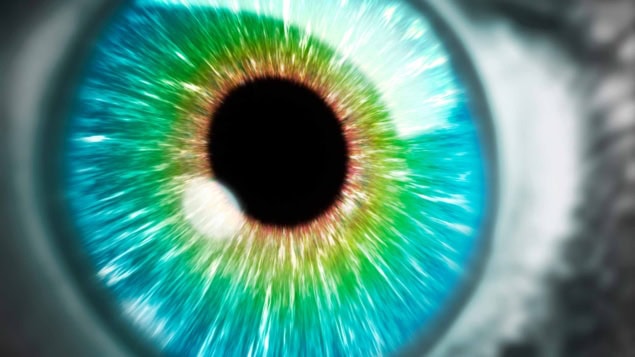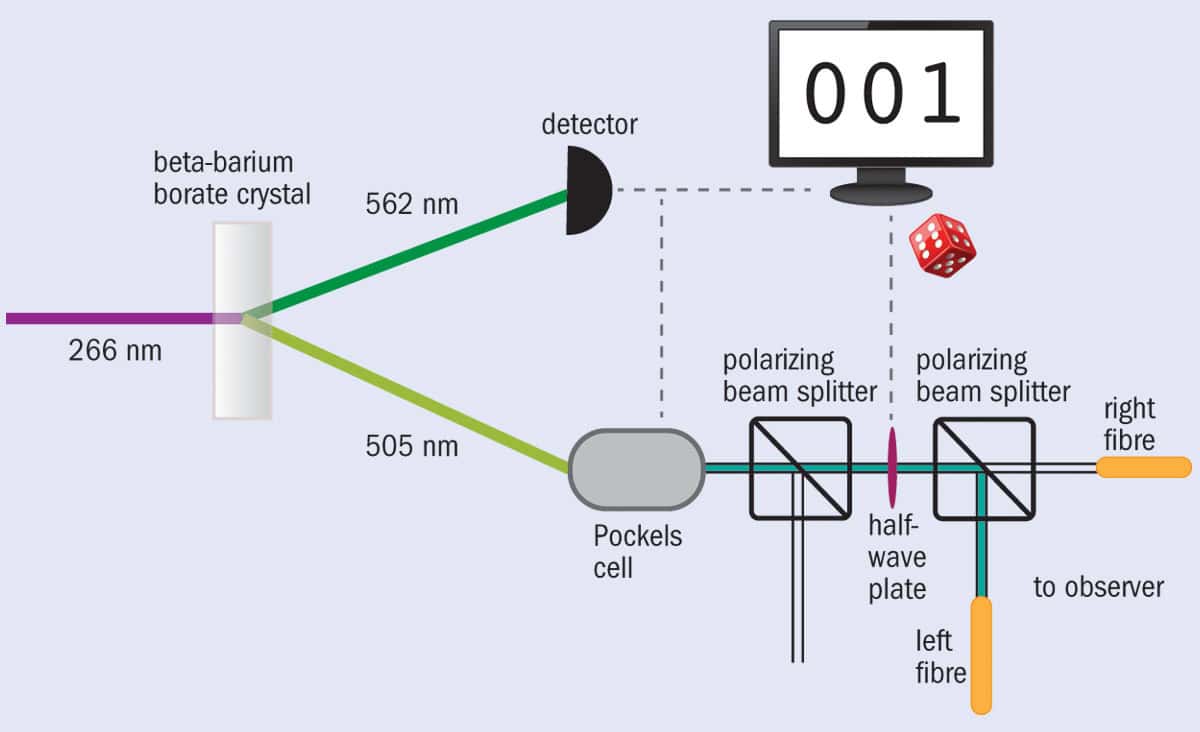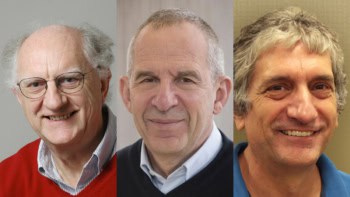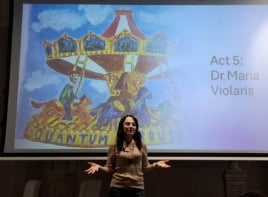The decades-old question of whether humans can see individual photons is on the brink of being answered thanks to advances in quantum optics. A positive result would let us use human observers as “detectors” to explore quantum effects such as entanglement, as Rebecca Holmes explains

On the eighth floor of the psychology department, in a small room with a light-proof door, I’ve spent hours in darkness testing a sensitive instrument – my own eye. During those hours I’ve fallen asleep, forgotten the time of day and found that total darkness doesn’t always look dark. I sometimes see phantom flashes like faraway fireflies, or the static of a television tuned to a vacant station. These are distractions from what I’m looking for: a flash of just a few photons – individual particles of light.
Next door, in a dark room of its own, a delicate apparatus generates the light my eyes are trying to see. This strange light is unlike any natural light source, and it can do things that normal light could never do. To understand how unusual this device is, think of as many different “normal” light sources as you can: light bulbs, light-emitting diodes, lasers, the Sun, the Moon, glowing embers, weird deep-sea fish, the Northern Lights. All emit photons randomly. It’s possible to make them extremely dim, so that on average they emit one photon every second, but there’s always a chance of getting two or three photons instead. There’s no reliable way to get just one photon every time.
But one photon is exactly what I need. The research project I’m working on is a collaboration between psychology and physics, and we’re using the technology of quantum optics to study how the human visual system responds to extremely small amounts of light. In particular, can the eye detect a single photon? If not, how many photons does it need?
Early experiments
Some of the most reliable early experiments on this question were conducted at Columbia University, US, in the 1940s. Austrian-born biophysicist Selig Hecht and his colleagues presented people with dim flashes of light calibrated to different intensities, and asked them if the flashes were visible or not. They determined how often people would say “yes” for each intensity, and with some assumptions about how the number of photons in each flash varied, they estimated that 5–7 photons needed to be detected by the retina for an observer to perceive light. These just-visible flashes actually contained many more than 5–7 photons, because about 90% of the light that hits the human eye is lost before it can be detected, for example via reflections from the cornea.
About 90% of the light that hits the human eye is lost before it can be detected, for example via reflections from the cornea
Across the Atlantic, H A van der Velden and Maarten Bouman were conducting similar experiments in the Netherlands under German occupation, and they estimated that humans could see 1–2 photons. Bouman is said to have jokingly mentioned later that this lower threshold was perhaps due to “the special opportunities for long dark adaptations (thanks to the precautions taken against air raids)”.
These early experiments couldn’t directly measure light detection in retinal photoreceptor cells – something that is possible today. However, they did hint that photoreceptor cells were sensitive to single photons. Hecht knew that his 5–7 photons were spread over an area of the retina containing about 500 photoreceptors, so the cells were probably able to detect single photons, even if it seemed that the observers themselves couldn’t.
By the 1970s, studies of individual photoreceptor cells proved Hecht right. There are two types of these cells: cone cells, responsible for colour vision in daylight, and the more sensitive rod cells, which are used for night vision. In the lab, researchers learned how to extract an individual rod cell from a toad and connect it to an electric circuit. (The toad killing and cell extraction has to happen in darkness – like a grim darkroom photography class – since the dark adaptation necessary to optimize rod cells to function well in low lighting only happens in living animals. This is one reason I prefer working with living human volunteers.)
Humans, toads and other vertebrates have similar rod cells. When light hits a rod, it activates a molecule called rhodopsin, which sets off a chain reaction that changes the current of ions moving in and out of the cell. In the retina, this current alters the release of neurotransmitter chemicals from the cell, allowing it to pass the signal on to other cells. In the lab, researchers were able to show in toad rod cells that this same current creates measurable electric pulses down to the single-photon level.
Now it was certain that rod cells on a lab bench were able to sense single photons. The question remained, however, of whether these tiny signals could make it through the rest of the visual pathway to the brain – in other words, whether humans can perceive individual photons.
Singular source
All the studies of human vision at that time had a fundamental limitation: they weren’t able to make just one photon. It wasn’t until the late 1980s that researchers in the new field of quantum optics invented a way of producing very unusual light: a single-photon source. These devices were developed to research the quantum properties of light, including applications such as quantum cryptography and quantum computers. However, they’re also the perfect tool to finally answer the question of whether humans can see single photons.
About eight years ago, the pieces started to come together. Tony Leggett, a Nobel-prize-winning physicist at the University of Illinois in the US, was interested in one of the great mysteries of physics: why the strange rules of quantum mechanics don’t seem to apply in everyday life. He thought that if humans could see single photons, which are quantum particles, then studying how we perceive them could help to solve the mystery. So he brought together Frances Wang, an interested psychologist, and Paul Kwiat, a pioneer in the field of quantum optics who could design the necessary apparatus.
After they designed the experiment on paper, it was my job to build it. As a new graduate student, I knew little about optics or the human visual system. Quantum mechanics had been my favourite college physics class, so I had joined Kwiat’s quantum information research group – despite not really knowing what to expect. (“What’s it like doing quantum information research?” I remember asking him on the phone before I arrived. “Really cool,” he’d replied.)
1 A single-photon source

An ultraviolet laser creates pairs of green photons inside a beta-barium borate crystal. When a 562 nm “herald” photon is counted by a single-photon detector, its 505 nm partner must be there on the other side. In case the herald photon is lost (scattered by an optical component or just not detected), a Pockels cell and polarizing beam splitter act as a fast switch that only opens when a herald photon is actually detected. This prevents photons from going to the observer without being counted. By turning the laser off immediately after one cycle, this source can produce exactly one photon. After passing through the switch, the 505 nm photon is directed to either the left or the right optical fibre (the choice is made randomly by a computer) using a half-wave plate and a second polarizing beam splitter, and the fibre carries it to a human observer.
I learned that there’s a simple trick to making just one photon: first make two. Our single-photon source (see figure 1) relies on a crystal of beta-barium borate, which can split one photon into two “daughter” photons through a nonlinear optical effect called spontaneous parametric down-conversion. The split is triggered by quantum vacuum fluctuations, and it only happens for about one in a billion photons. That doesn’t sound like a lot, but when a laser beam with 1016 photons per second passes through the crystal, a stream of photon pairs comes out. The two photons in a pair travel in slightly different directions, so we can collect them into separate optical fibres. One fibre goes straight to a single-photon detector and when it measures a photon, we know that its undetected partner, created at exactly the same time, is there too – in fact, we can send it to a human observer. Rod cells are most sensitive to green light, so we use an ultraviolet laser to create single photons with a wavelength of about 505 nm – a luminous bright green like a traffic signal on a dark road.
Although the crystal is small, the entire single-photon source fills an optical breadboard the size of a workbench and weighs more than 90 kg. Building it required months of carefully placing lenses, tilting mirrors and turning knobs in the dark while watching dim red numbers go up or down. When it was ready, we moved it from the second floor of the physics department to the eighth floor of the psychology department with the help of a pickup truck and my strongest lab mates. I realigned the components and got ready to begin tests with actual human observers.
Each session requires about two hours in total darkness. (I’m lucky to have an endless supply of undergraduate physics student volunteers who will do anything in the name of science.) First, there’s a 30-minute period of dark adaptation to optimize the observer’s night vision. For the first 15 minutes the volunteers just relax in the dark, and for the second 15 they do practice trials. During this time, pupil dilation and chemical changes in the retina make the observer’s eyes at least a million times more sensitive than they are in daylight.
When the observer is fully dark-adapted, they position their head in a chin rest and look straight ahead at a dim red cross hairs. The single-photon source sends a flash of light to one of their eyes, and the light is randomly assigned to appear on either the left or the right side of the cross hairs. The observer’s job is to correctly choose which side the light appeared on – left or right – in 300 repetitions of this task. It does get boring, so we make it a (still pretty boring) game by playing a sound after each trial to tell the observer whether they got the answer right or not: a happy “ta-da!” sound for a correct answer, and a disappointing buzz for an incorrect answer.
Asking the observer to choose left or right instead of just asking “did you see it or not?” is an important feature of our experiment. With random noise in the visual system that can create distracting phantom flashes even in total darkness, it’s hard to be sure you’re seeing the real thing. Single-photon detection might not even be conscious – sometimes I have a hunch that the flash was on the right, without knowing why (and sometimes I’m sure I saw it on the left and I get the “wrong” buzzer – argh!).
But the data don’t lie – if an observer is able to choose left or right with better than 50-50 accuracy and the effect is statistically significant, we know they must have been able to see the light (either that or they’re psychic). We’re still working on collecting enough data, but we plan to use this technique to test once and for all whether humans can see single photons.
We’ve already found that people can see flashes of about 30 photons, and we think only three of those photons actually make it to the retina on average. Like Hecht back in the 1940s, we have to average and estimate with multiple photons, but with single photons we’ll know for sure – either one photon or zero will be detected each time.
In the dark
We’re not the only ones working on experiments like this. In 2016 a Vienna-based group, led by physicist Alipasha Vaziri from Rockefeller University in the US, reported they had demonstrated single-photon vision using a similar single-photon source (Nature Comms 7 12172). It was an interesting study that used a clever technique – observers had to judge accurately when a photon arrived instead of where. However, my colleagues and I are concerned that the reported results are ambiguous. That’s because in a key subset of trials (rated “high confidence” by the observers), the average accuracy was so high that it didn’t seem to fit with the rest of the data, and weaker statistical tests were used. We think more convincing proof of single-photon vision is still needed. Whether our concerns turn out to be valid or not, we feel that independent replication is important for a question that has been so challenging to answer.

In the meantime, my colleagues and I have studied other aspects of the visual system. By varying the length of very dim flashes of light and the number of photons they contain, we have measured the equivalent of “exposure time” in the eye – the time window during which photons are added up into one larger signal. This is similar to the time that a camera shutter is open, but it’s more complex in the eye – the exposure is adjusted dynamically for different conditions, and can even be affected by a memory of a previous image. For flashes of light that are relatively easy to see, the exposure time is typically one tenth of a second. We found that when only a few photons are present, the eye adds up signals for almost a full second (probably in retinal processing after the photoreceptors), dramatically improving its ability to detect weak flashes.
If the research community does prove that humans are able to see single photons, we might be able to fulfil Leggett’s dream of testing quantum effects through the visual system. Instead of sending a photon to either the left or the right side of the eye, we could send a photon in a quantum superposition of both left and right! How would that look to an observer? Standard quantum mechanics predicts that the photon should collapse to one side or the other too quickly to notice, but no-one knows for sure. We could even use a human observer as a “detector” in a test of nonlocality, the instantaneous “spooky” action at a distance of entangled photons. More than 100 years after Albert Einstein suggested that light was made of particles, we now have the chance to ask these strange new questions.



